Dear Reader, in this age of AI created content, please support with your goodwill someone who works harder to provide the human-made. Sign up at the top of the lefthand column or bottom of this page. You will receive my hand illustrated monthly newsletter RESTORE NATURE and access to the biodiversity garden design course as I write...and nothing else, I respect your time. I am also removing the advertizing as best I can as its become intrusive inappropriate and pays me nothing.
Inorganic and organic mulch conserve water
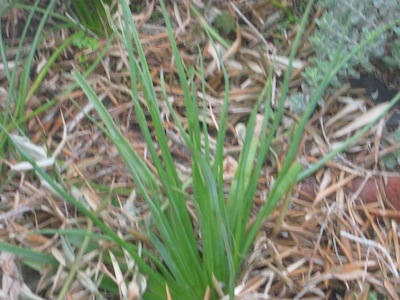 organic mulch (olive) and living edible mulch (Trachyadra)
organic mulch (olive) and living edible mulch (Trachyadra)The previous article covered issues to do with transplanting, positioning, and soil nutrients, soil depth, and the sun and water requirements of plants and how to plan for harmony with these givens for a water-wise garden. This article is the first on water-wise garden maintenance. The next will deal with how to water.
Water-wise garden maintenance 1
Mulching
We have spoken of how to conserve water by planting to cover the ground. The other essential way of covering the ground and keeping it cool in a hot climate is mulch. This can be a layer of organic material or an inorganic mulch like plastic sheeting. A neat appearance, weed suppression and water conservation are the most common reasons for applying mulch. Apply organic mulch at least 15cm thick and replenish it annually.
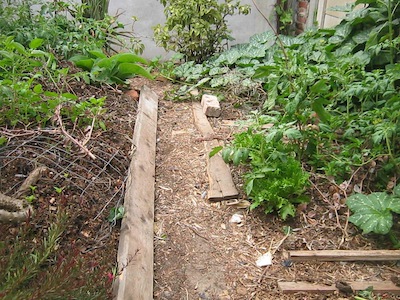 mulch on the path and beds conserves water and improves the soil in a vegetable patch
mulch on the path and beds conserves water and improves the soil in a vegetable patchOrganic mulch
There are many benefits to mulches with organic materials. In addition to shielding the soil from heat, erosion by rain and conserving water through reducing evaporation from the soil, mulch supports the presence and the chemical activity of soil microfauna. Bacterial action occurs mostly on the surface, in the presence of oxygen, so roots feed there and mulch protects the root hairs from heat and desiccation. The organic material in the mulch and the soil organisms help restore the humic content of soil. This improves its crumb structure, water and mineral retention and temperature profiles, ameliorating extreme soil temperatures, and allowing better penetration by rain or irrigation.
Organic and living plant mulches also house beneficial predatory insects that help keep pests in check. Other soil organisms like fungi help with nutrient dispersal in the ground. Decayed mulch also acts as a weak fertilizer. Mulch can substitute for soil if your garden is on bedrock.
Mulched plants tend to be stronger and healthier and more disease resistant. Mulched gardens are less dependent on the gardener and can be left alone for longer.
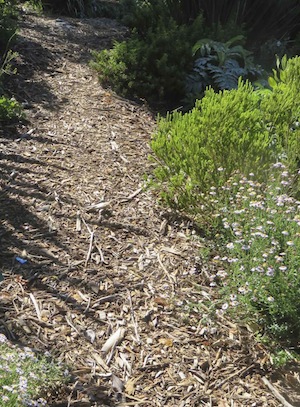 wood chip is the most common mulch at Kirstenbosch and the Fynbos plants seem to thrive on it
wood chip is the most common mulch at Kirstenbosch and the Fynbos plants seem to thrive on itLight coloured mulches reflect more heat. Add wet, green leaves in the dryness of summer, and dry leaves in the soggy Mediterranean winters. Woody materials need added nitrogen, as they soak up nitrogen during the decaying process, depriving nearby plants of nitrogen. I find dilute, mature urine to be a perfect additive to woody mulch, but with caution, as many drought tolerant plants, especially from South Africa with its leached soils, will actually suffer from high nitrogen in the soil. Add wood ashes to mulch for an extra mineral boost, depending on the origin of your plants.
Materials for mulch are swept up leaves, nut shells, rice hulls, straw, lawn clippings and shredded garden and kitchen waste. Combine fine soft leaves and lawn clippings with coarse material to aerate it. Wood mulch such as wood shavings, sawdust, bark chips, also need extra nitrogen to break down. Pine needles acidify and break down very slowly, and also need extra nitrogen. Acid soil provided by pine needles is ideal for some Cape Fynbos plants, but then be cautious with the nitrogen or leave it out. Van Jaarsveld actively encourages the use of mulches in South African and Namibian gardens, using gravel from local stone in arid regions, and preparing compost by the trench method (van Jaarsveld 2010:27). A heap desiccates so easily in our dry climate.
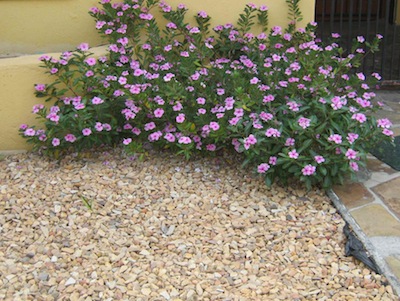 a double inorganic mulch, black plastic peeping out at the bottom right, and stone. It conserves water, but blocks air.
a double inorganic mulch, black plastic peeping out at the bottom right, and stone. It conserves water, but blocks air.Inorganic mulch
Inorganic mulches like plastic sheeting do not feed the soil life. I’ve seen several neighbours use plastic sheets placed under gravel to completely eliminate weeds. Pebbles and gravel can also be used alone, but it is an art to make these work in the long term, and they often need to be relaid or they become invaded by weeds. They need to be laid in size structured and compacted layers, like a gravel road, to be more lasting. Inorganic mulches do not convert to humus, it is true, but they do protect roots from drying out, keep weeds down, and pebbles and gravel reflect heat upwards, which benefits some succulents.
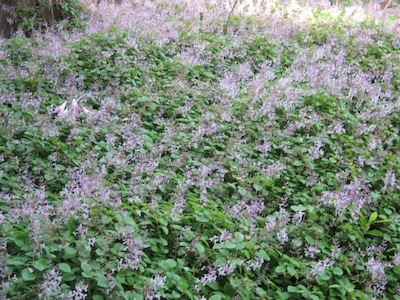 a shade loving ground cover is a mulch with benefits
a shade loving ground cover is a mulch with benefitsLiving mulch
The ground covers we have previously discussed could be seen as a form of living mulch. Green manures like alfalfa and clover also make an excellent living mulch and serve as lawn replacements. In South Africa they require a lot of watering though. In the permaculture garden the living mulch can be edible. I’m working on propagating native ‘edible-green-carpet’ vegetation. Creeping herbs are available on the market and there are lovely ‘weeds’ like yellow oxalis and purslane which can also be eaten, sorrel in moderation due to the oxalix acid.
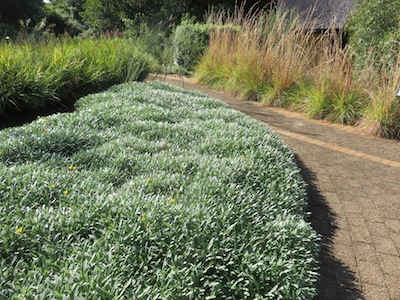 lawn replacement with Gazania (flowering). You could also choose a medicinal or edible plant
lawn replacement with Gazania (flowering). You could also choose a medicinal or edible plantThe next article in the water-wise Mediterranean garden series is on how to water wisely, especially drought tolerant plants
------
home page for tons of ideas on eco friendly gardening
------
natural garden design, its benefits
------
album of lawn replacements, mulch and indigenous ground covers
------
albums of Mediterranean gardens
Restore Nature Newsletter
I've been writing for four years now and I would love to hear from you
Please let me know if you have any questions, comments or stories to share on gardening, permaculture, regenerative agriculture, food forests, natural gardening, do nothing gardening, observations about pests and diseases, foraging, dealing with and using weeds constructively, composting and going offgrid.
You’re a home gardener ! Share your experiences and questions !
We all know about home gardening. Tell us about your successes, challenges and ask about issues that bother you. You may have the luxury of a back garden, but there are other ways we learn. Few people age without growing something or buying vegetables during their lives ! It is absolutely guaranteed that you have learned things which can help others on their gardening journey.
We invite you to share your stories, ask questions, because if a thing has bothered you it will bother others too. Someone may have a solution ! No question is too small. There is learning for everyone involved, for you, for me (yes, I learn from every question), for us all. Exciting stuff !
We are starting on a new journey. Every week we will profile your letters ! The best stories and questions we receive.
SEARCH
Order the Kindle E-book for the SPECIAL PRICE of only
Prices valid till 30.09.2023
Recent Articles
-
garden for life is a blog about saving the earth one garden at a time
Apr 18, 25 01:18 PM
The garden for life blog has short articles on gardening for biodiversity with native plants and regenerating soil for climate amelioration and nutritious food -
Cape Flats Sand Fynbos, Cape Town's most endangered native vegetation!
Apr 18, 25 10:36 AM
Cape Flats Sand Fynbos, a vegetation type found in the super diverse Cape Fynbos region is threatened by Cape Town's urban development and invasive alien plants -
Geography Research Task
Jan 31, 25 11:37 PM
To whom it may concern My name is Tanyaradzwa Madziwa and I am a matric student at Springfield Convent School. As part of our geography syllabus for this
"How to start a profitable worm business on a shoestring budget
Order a printed copy from "Amazon" at the SPECIAL PRICE of only
or a digital version from the "Kindle" store at the SPECIAL PRICE of only
Prices valid till 30.09.2023







